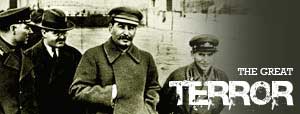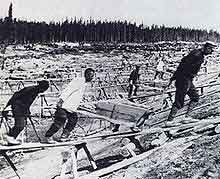
FGF E-Package
Can Such Things Be?
March 19, 2013
Soviet History Teaches Us What Becomes of a Disarmed Population
by David Coker

EVANSVILLE, IN — The gun control hysteria and propaganda emanating from President Barak Obama, members of Congress, state legislators, mayors of major cities and assorted interest groups finds them in a considerable dither. With some wanting no less that the eventual confiscation of any weapon that can shoot more than one round of ammunition upon reloading, a rancorous debate and considerable push-back from the grass roots of the nation is inevitable.
The very use of the phrase "assault weapon" — a propaganda term for any semi-automatic firearm — has been repeated so many times by media pundits that the words have lost relevancy.
Within this typically hysterical shouting match, let us pause for a moment and reconsider who and what we are as a nation and think for a moment about what becomes of a population which is totally disarmed by despotic leaders.
Perhaps the most splendid example of what becomes of a totally disarmed public can be gleaned from a reading of the history of the Soviet Union — more specifically, all three volumes of The Gulag Archipelago by Alexander Solzhenitsyn.
This monumental, award-winning work describes in great detail the many facets of Soviet brutality: specifically, incarcerations, show-trials, mass resettlement or imprisonment within the hundreds of forced labor camps which made up the Gulag throughout the Russian land mass.
Two particularly severe examples of Soviet and later Nazi oppression with regard to the Soviet peasantry come to mind — the construction of the Belomor Canal and Soviet and later Nazi atrocities within the Southeastern Russian province of Ukraine.
In the second volume of the three volume epic, Solzhenitsyn takes us by the hand through what he calls the "Destructive Labor Camps," in the region between the White Sea port of Belomorsk, to Leningrad (St. Petersburg) on the Baltic Sea. As one of his first official acts as premier Soviet leader, Joseph Stalin ordered the Soviet state to build the 140-mile navigational canal using forced labor housed in the network of the camps. Using wooden wheelbarrows, dray carts, a few horses, picks, shovels and axes, over 100,000 slave laborers commenced to dig the enormous works project out of the frozen earth and rock by hand. An apparent priority of Comrad Stalin, the edict came down that the work must be finished in 20 months during the time frame from September, 1931 until April, 1933.
Although specific estimates remain unclear, Solzhenitsyn states that during the first winter of 1931 and 32, as many as 100,000 peasants starved or were worked to death throughout the camp system, an amount equal to the total estimated number of workers throughout the project at any given time. Replacements were obviously relocated constantly and those who survived this brutality went on to build yet another similar canal from Moscow to the Volga River.
A slave labor camp in the Baltic Canal.
The other gut-wrenching example of what can befall a disarmed population involves the poor inhabitants of the Ukraine, specifically a town called Vinnitsa, an administrative center on the Bug River.
During the 1930s, Stalin imposed a system of collective farming upon rural areas throughout Russia. The Ukraine, long thought of as the "breadbasket of Mother Russia," was inhabited largely by Slavs, Poles, Jews, Gypsies and others who had been relocated there after the October Revolution.
While Soviet efforts were met with some resistance, with the mass killings of livestock and property damage, a system of forced starvation was imposed upon the people of the Ukraine ... between seven and eleven million people are thought to have starved to death.
While Soviet efforts were met with some resistance, with the mass killings of livestock and property damage, a system of forced starvation was imposed upon the people of the Ukraine and more specifically the residents of Vinnitsa.
During about the same period of the building of the Belomor Canal, between seven and eleven million people are thought to have starved to death.
But in addition to the mass starvation, tell-tale evidence of genocide was uncovered in 1938 when some 9,439 corpses were found in a mass grave in Vinnitsa, the hands of the victims were tied and they were shot in the back of the head. These were obviously prisoners who had been killed in incarceration without trials and the bodies moved to this mass grave in the dark of the night.
Years later, in 1943 during the Nazi occupation of the Ukraine, other mass graves in the town were uncovered by SS troops who were dispatched to the region. During the occupation, some 28,000 Jews were slaughtered in the immediate region of Vinnitsa. One of the most famous, iconic photographic images of World War II was taken here — a picture of an SS officer of Einsatzgruppe D, a Nazi paramilitary group, is seen shooting "the last Jew in Vinnitsa" on his knees in front of a massed grave. While the Nazis attempted to use their discovery of the massed graves for propaganda purposes against Stalin and the Soviets, they themselves had plenty of blood on their hands after slaughtering over 900,000 Jews during the Ukrainian occupation.
Human nature ... teaches us that aggressive people take advantage of weaker or defenseless people. History confirms this. Tyranny and genocide are inevitable when populations are disarmed. People who say "it can't happen here" are deluding themselves.
Human nature, largely unchanged since the Babylonian captivity of the children of Israel, teaches us that aggressive people take advantage of weaker or defenseless people. History confirms this. Tyranny and genocide are inevitable when populations are disarmed. People who say "it can't happen here" are deluding themselves.
One salient reason the United States has never been invaded by a foreign power is because the population has remained armed under the rights guaranteed by the second amendment to the Constitution. Those who own firearms in this country understand this and will do what is necessary to protect their freedoms.
This article appeared originally in the Evansville (Indiana) Courier & Press. Reprinted with permission.The Fitzgerald Griffin Foundation needs your help to continue making these columns available. To make a tax-deductible donation, click here.
© 2013 Fitzgerald Griffin Foundation
